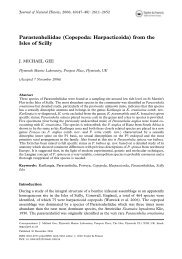An Updated Classification of the Recent Crustacea
An Updated Classification of the Recent Crustacea
An Updated Classification of the Recent Crustacea
Create successful ePaper yourself
Turn your PDF publications into a flip-book with our unique Google optimized e-Paper software.
Submitted by Roger L. Kaesler,<br />
Paleontological Institute,<br />
The University <strong>of</strong> Kansas<br />
OSTRACODA<br />
Spelling <strong>of</strong> Suborder Halocyprina Dana, 1853.<br />
Dana (1853: 1281) based his subfamily Halocyprinae<br />
and family Halocypridae on his new genus Halocypris.<br />
Therefore, at least according to present<br />
rules, <strong>the</strong> subfamily should be Halocypridinae and<br />
<strong>the</strong> family Halocyprididae. Dana did not use <strong>the</strong><br />
names Halocyprina or Halocyprida. If you are basing<br />
your Halocyprina and Halocyprida on <strong>the</strong> family<br />
name Halocyprididae, it seems to me that, to be<br />
consistent, <strong>the</strong> suborder should be Halocypridina<br />
and <strong>the</strong> order should be Halocypridida. If you are<br />
basing your Halocyprina on <strong>the</strong> commonly used<br />
name for <strong>the</strong> order, Halocyprida, <strong>the</strong>n I think you<br />
are correct in using Halocyprina. Possibly, you<br />
should explain your reasoning for using Halocyprina,<br />
because I think that you are creating a new<br />
spelling for <strong>the</strong> suborder. [Editors’note: we retained<br />
<strong>the</strong> spelling Halocyprida for <strong>the</strong> order, as listed in<br />
Bowman and Abele (1982: 13), and Halocyprina<br />
for <strong>the</strong> suborder based on <strong>the</strong> order name.]<br />
Submitted by Louis Kornicker,<br />
Smithsonian Institution,<br />
National Museum <strong>of</strong> Natural History<br />
STOMATOPODA<br />
I am leery <strong>of</strong> following suggestions made in abstracts<br />
concerning higher taxonomy. Cappola has<br />
never published her Pseudosquilloidea (which I see<br />
you accept) with documented reasons for her decision.<br />
In fact, some <strong>of</strong> <strong>the</strong> new analyses <strong>of</strong> Ahyong<br />
and H<strong>of</strong> (not yet published) would not entirely support<br />
such an arrangement.<br />
Thus, while we are at it, you need to turn to<br />
[page 86 in original draft]. I suggest for now you<br />
simply leave all <strong>the</strong> ‘‘gonodactyloid’’ families in one<br />
superfamily Gonodactyloidea. When we can identify<br />
clear clades and suggest valid groupings, you<br />
can change it; or when people actually publish revisions<br />
in a refereed journal.<br />
Submitted by Frederick R. Schram,<br />
Zoölogisches Museum, Amsterdam<br />
AMPHIPODA<br />
Although I agree in general with <strong>the</strong> thrust <strong>of</strong> your<br />
arguments, you fail to recognise <strong>the</strong> complexity <strong>of</strong><br />
amphipod morphology and <strong>the</strong> lack <strong>of</strong> family level<br />
revisions, which makes <strong>the</strong> development <strong>of</strong> an acceptable<br />
classification extremely difficult. Suborder<br />
and families were established long ago and for <strong>the</strong><br />
most part have never been revised. Superfamilies<br />
were to a certain extent based on gestalt, which<br />
worked well for some groups like corophioids, lysianssoids<br />
and haustorioids, but failed for families<br />
which didn’t show clear body-plan relationships.<br />
Even groups as seemingly distinctive as <strong>the</strong> Lysianassoidea<br />
are very difficult to define morphologically<br />
when all genera are considered. When Barnard<br />
and Karaman (1991) collapsed <strong>the</strong> majority<br />
<strong>of</strong> corophioid families, <strong>the</strong>y did it because <strong>the</strong>se traditional<br />
families (although workable when <strong>the</strong>y<br />
were originally established) were no longer definable<br />
and could no longer be supported. Genera described<br />
over <strong>the</strong> years had been pigeon-holed into<br />
one family or ano<strong>the</strong>r until any characters which<br />
might define <strong>the</strong>m had become totally diluted. It<br />
will take a large effort using modern phylogenetic<br />
techniques to develop an acceptable classification.<br />
The results <strong>of</strong> <strong>the</strong>se works have to be published in<br />
reputable journals after careful peer-group review.<br />
Attempts to revise classifications are underway. For<br />
instance, Lowry and Myers are currently revising<br />
<strong>the</strong> iphimedioid group and Myers and Lowry are<br />
revising <strong>the</strong> corophioid group. The website<br />
www.crustacea.net has recently been established to<br />
publish information and retrieval systems (electronic<br />
monographs) for all crustaceans. For instance,<br />
Watling and his students are currently preparing<br />
cumacean data bases and Lowry and his students<br />
are working on amphipod data bases for <strong>the</strong> website.<br />
It is unfortunate that <strong>the</strong> use <strong>of</strong> poorly refereed<br />
journals and pseudophylogenetic methodologies<br />
have been used in some cases to produce untestable<br />
and, in some cases, unacceptable classification systems.<br />
Because <strong>of</strong> <strong>the</strong>se problems, we currently list our<br />
taxa alphabetically in <strong>the</strong> Amphipoda. I do not see<br />
<strong>the</strong> problem. All classifications are hypo<strong>the</strong>ses<br />
which change as new hypo<strong>the</strong>ses are produced. In<br />
a large monograph, it is fine to discuss and list <strong>the</strong><br />
phylogenetic classification, but probably <strong>the</strong> taxonomic<br />
section should be alphabetical. Trying to find<br />
families or genera listed phylogenetically in a large<br />
monograph can be a nightmare for those not in <strong>the</strong><br />
know (basically everyone but experts). It is relatively<br />
easy, for example, to find a family level taxon<br />
in Barnard and Karaman (1991). One does not<br />
have to continually consult <strong>the</strong> index.<br />
Submitted by Jim Lowry,<br />
Australian Museum, Sydney<br />
AMPHIPODA: GAMMARIDEA<br />
As Ed Bousfield was not present at <strong>the</strong> amphipod<br />
conference in Amsterdam to defend <strong>the</strong> value <strong>of</strong><br />
phyletic vs. alphabetical classification <strong>of</strong> <strong>the</strong> Gammaridea,<br />
several points raised in <strong>the</strong> Vader-Baldinger-K-S-Watling<br />
report seem largely matters <strong>of</strong> mechanics<br />
ra<strong>the</strong>r than matters <strong>of</strong> phyletic substance.<br />
Some points <strong>of</strong> your recent ‘‘critique’’ summary<br />
may require modification, viz: (1) ‘‘<strong>the</strong> schedules <strong>of</strong><br />
Jerry Barnard and Ed Bousfield (are) <strong>of</strong>ten not very<br />
compatible’’ and (2) ‘‘. . . not espousing one worker’s<br />
view over ano<strong>the</strong>r.’’ With all due respect to Jerry’s<br />
enormous contribution to gammaridean taxonomy,<br />
his formal ‘‘track record’’ in gammaridean<br />
phylogeny was actually quite modest in scope.<br />
Contributions in Science, Number 39 Appendix I: Comments and Opinions 107











